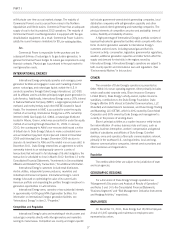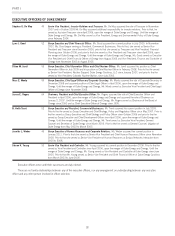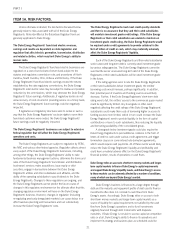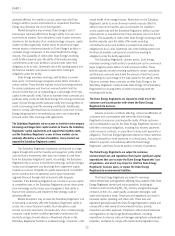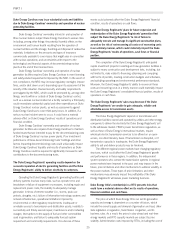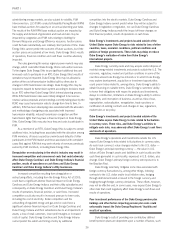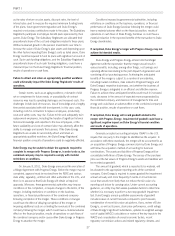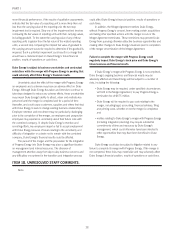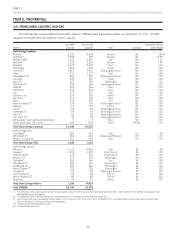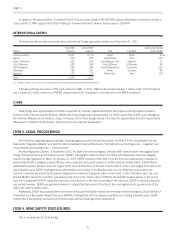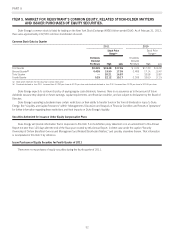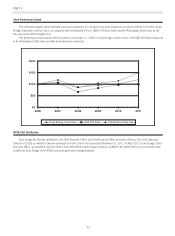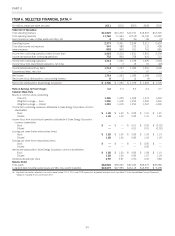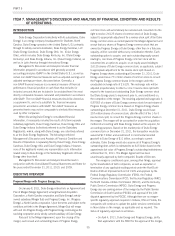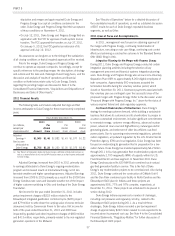Duke Energy 2011 Annual Report Download - page 47
Download and view the complete annual report
Please find page 47 of the 2011 Duke Energy annual report below. You can navigate through the pages in the report by either clicking on the pages listed below, or by using the keyword search tool below to find specific information within the annual report.
PART I
as the rates of return on plan assets, discount rates, the level of
interest rates used to measure the required minimum funding levels
of the plans, future government regulation and Duke Energy’s
required or voluntary contributions made to the plans. The Subsidiary
Registrants participate in employee benefit plans sponsored by their
parent, Duke Energy. The Subsidiary Registrants are allocated their
proportionate share of the cost and obligations related to these plans.
Without sustained growth in the pension investments over time to
increase the value of Duke Energy’s plan assets and depending upon
the other factors impacting Duke Energy’s costs as listed above, Duke
Energy could be required to fund its plans with significant amounts of
cash. Such cash funding obligations, and the Subsidiary Registrants’
proportionate share of such cash funding obligations, could have a
material impact on the Duke Energy Registrants’ financial position,
results of operations or cash flows.
Failure to attract and retain an appropriately qualified workforce
could unfavorably impact the Duke Energy Registrants’ results of
operations.
Certain events, such as an aging workforce, mismatch of skill
set or complement to future needs, or unavailability of contract
resources may lead to operating challenges and increased costs. The
challenges include lack of resources, loss of knowledge and a lengthy
time period associated with skill development. In this case, costs,
including costs for contractors to replace employees, productivity
costs and safety costs, may rise. Failure to hire and adequately train
replacement employees, including the transfer of significant internal
historical knowledge and expertise to the new employees, or the
future availability and cost of contract labor may adversely affect the
ability to manage and operate the business. If the Duke Energy
Registrants are unable to successfully attract and retain an
appropriately qualified workforce, the Duke Energy Registrants’
financial position or results of operations could be negatively affected.
Duke Energy may be unable to obtain the approvals required to
complete its merger with Progress Energy or, in order to do so, the
combined company may be required to comply with material
restrictions or conditions.
On January 8, 2011, Duke Energy announced the execution of
a Merger Agreement with Progress Energy. Before the merger may be
completed, approval must be received from the FERC and various
state utility, regulatory, antitrust and other authorities in the U.S., and
thereisnoassurancethatDukeEnergywillobtainallrequired
approvals. Moreover, these governmental authorities may impose
conditions on the completion, or require changes to the terms, of the
merger, including restrictions or conditions on the business,
operations, or financial performance of the combined company
following completion of the merger. These conditions or changes
could have the effect of delaying completion of the merger or
imposing additional costs on or limiting the revenues of the combined
company following the merger, which could have a material adverse
effect on the financial position, results of operations or cash flows of
the combined company and/or cause either Duke Energy or Progress
Energy to abandon the merger.
Conditions imposed by governmental authorities, including
restrictions or conditions on the business, operations, or financial
performance of Duke Energy Carolinas following the merger could
have a material adverse effect on the financial position, results of
operations or cash flows of Duke Energy Carolinas or could have a
material reduction in the expected benefits of the transaction to Duke
Energy shareholders.
If completed, Duke Energy’s merger with Progress Energy may not
achieve its intended results.
Duke Energy and Progress Energy entered into the Merger
Agreement with the expectation that the merger would result in
various benefits, including, among other things, cost savings and
operating efficiencies relating to the joint dispatch of generation and
combining of fuel purchasing power. Achieving the anticipated
benefits of the merger is subject to a number of uncertainties,
including market conditions, risks related to Progress Energy’s and
Duke Energy’s respective businesses, and whether the business of
Progress Energy is integrated in an efficient and effective manner.
Failure to achieve these anticipated benefits could result in increased
costs; decreases in the amount of expected revenues generated by
the combined company and diversion of management’s time and
energy and could have an adverse effect on the combined company’s
financial position, results of operations or cash flows.
If completed, Duke Energy will record goodwill related to the
merger with Progress Energy. Impairment of goodwill could have a
significant negative impact on Duke Energy’s financial condition
and results of operations.
Generally accepted accounting principles (GAAP) in the U.S.
require that one party to the merger be identified as the acquirer. In
accordance with these standards, the merger will be accounted for as
an acquisition of Progress Energy common stock by Duke Energy and
will follow the acquisition method of accounting for business
combinations. The assets and liabilities of Progress Energy will be
consolidated with those of Duke Energy. The excess of the purchase
price over the fair values of Progress Energy’s assets and liabilities will
be recorded as goodwill.
The amount of goodwill, which is expected to be material, will
be allocated to the appropriate reporting units of the combined
company. Duke Energy is required to assess goodwill for impairment
at least annually and more frequently if events or circumstances
occur that would more likely than not reduce the fair value of a
reporting unit below its carrying value. Under current accounting
guidance, an entity may first assess qualitative factors to determine
whether it is necessary to perform a two-step goodwill impairment
test. Duke Energy’s annual qualitative assessments of goodwill
include reviews of current forecasts compared to prior forecasts,
consideration of recent fair value calculations, if any, review of Duke
Energy’s, as well as its peers, stock price performance, credit ratings
of Duke Energy’s significant subsidiaries, updates to weighted average
cost of capital (WACC) calculations or review of the key inputs to the
WACC and consideration of overall economic factors, recent
regulatory commission actions and related regulatory climates, and
27


